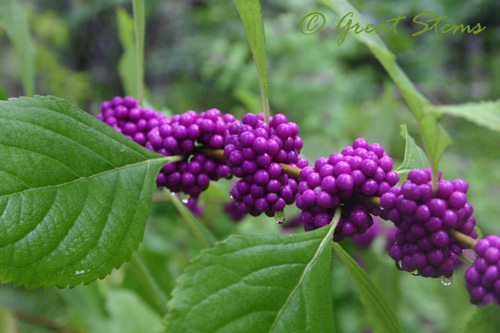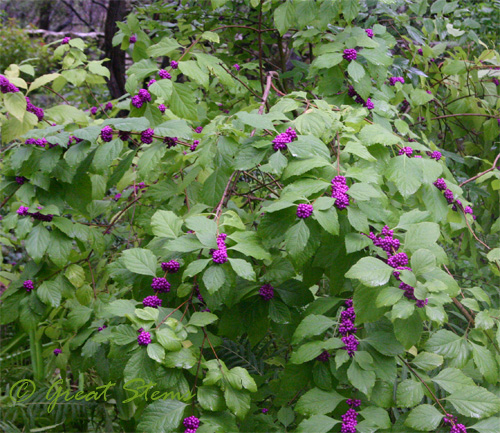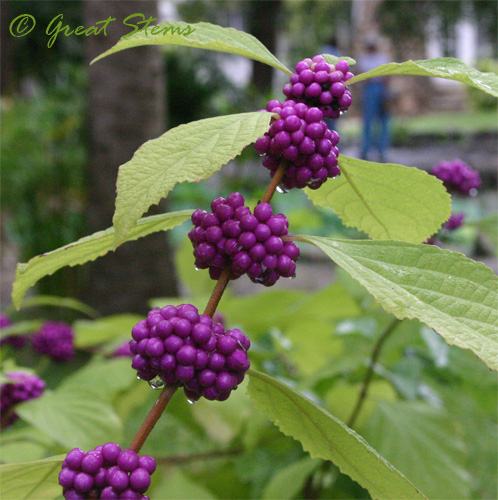The American Beautyberry, Callicarpa americana, is truly a sight to behold in the fall. The strikingly vibrant magenta-colored berries stand out boldly against the light-green foliage of this open, airy shrub.
 But aside from its beauty, what makes this shrub truly valuable is that it is a fall and winter food source for more than 40 different songbird species, as well as other birds. It also is enjoyed by mammalian wildlife, including the opossum and raccoon. Its deer resistance probably depends on your area and the harshness of seasonal weather. In some areas, deer leave the mature plants alone, but they’re happy to nibble on young shrubs and sometimes the berries. In general, though, it’s best to plant the shrub in a protected area if you are concerned about deer.
But aside from its beauty, what makes this shrub truly valuable is that it is a fall and winter food source for more than 40 different songbird species, as well as other birds. It also is enjoyed by mammalian wildlife, including the opossum and raccoon. Its deer resistance probably depends on your area and the harshness of seasonal weather. In some areas, deer leave the mature plants alone, but they’re happy to nibble on young shrubs and sometimes the berries. In general, though, it’s best to plant the shrub in a protected area if you are concerned about deer.
American Beautyberry is an excellent shrub for understory growth, and understory plants are a key part of successful wildlife habitats. They can provide food and/or places to hide, and despite its airy nature, the Beautyberry does both, particularly when several of the shrubs form a small colony.
 In the summer, the shrub has delightful pale flowers. But it is the beautiful clusters of purple berries that really provide that wow factor come fall. There is also a white variety, but if choosing a color most attractive to birds, I’d stick with purple.
In the summer, the shrub has delightful pale flowers. But it is the beautiful clusters of purple berries that really provide that wow factor come fall. There is also a white variety, but if choosing a color most attractive to birds, I’d stick with purple.
 The deciduous shrub is typically 5-6 feet tall when mature, but I’ve seen some get more than 8 feet tall. It prefers partial sun/partial shade, but with extra water and attention, it can handle more sun, too. But as an understory plant, it is at its best.
The deciduous shrub is typically 5-6 feet tall when mature, but I’ve seen some get more than 8 feet tall. It prefers partial sun/partial shade, but with extra water and attention, it can handle more sun, too. But as an understory plant, it is at its best.
American Beautyberry, according to wildflower.org, is native to all the states of the southern U.S., on up into Maryland, Missouri, and Oklahoma. It thrives in a variety of conditions of soil, water, and light conditions, and it is easily grown from seed as well. A worthy plant for your wildlife habitat!
I love the Beautyberry in my NW garden. Your post makes me want to buy more!
I’m jealous, that is gorgeous. I can’t believe the vibrant color.
Hi Meredith… Thank you for visiting Think(ing) Green Thurday. I would be happy to have you participate if you would like. Also please visit my main blog because I have a Nature Notes meme also.
Here is the place that I bought my pesticide-free lawn signs…
Beyond Pesticides –Michelle–
Ooooh…beautiful! I want that too. Kaija
The color is out of this world. Nice post, Meredith!
Meredith, I always mean to plant a Beauty Berry, but haven’t. You give me good reason to. Thanks!
Glab you reminded me of the Beauty Berry I have just the spot for one.
Scott
That beautiful color makes me smile, Meredith, as we head toward autumn every year. It is beautiful, but it’s a very fleeting beauty in my garden – the mockingbirds don’t let the purple stick around very long!
Annie at the Transplantable Rose
thank you! i was wondering what this bush was after seeing several planted at the hill country galleria. i need to plant one out here…:)
i got my fall raised beds finally started. only 2 so far, we are going to get the other 2 built before spring but i did manage to get some things in the ground…just in time for this next bit of rain too..;) loving the wet weather!
have a great week! xoxo
This is a pretty awsome plant, great picture
Thanks, everyone — glad there is such kinship in admiration of such a unique and beautiful shrub. Cat, yay on the fall beds — I’ve got the tiniest little spinach and lettuce sprouts peeking up out of the soil now. The kohlrabi are growing, too! I still want three more beds built asap. Well, two I have actual fall plans for. But might as well build three at once, right?
Wow! These look like some sorta yummy grape candy.
Rosey
Hi Meredith, thanks for visiting my blog. I love your photography! (I’m still trying to figure out how to work my camera.) These berries are beautiful. I love reading about gardens located in other climate zones look forward to following your blog!
Thanks, Thomas. I enjoyed your blog, too. Today I was excited to see tiny little spinach and lettuce sprouts just now coming up through the soil. I might follow your lead and prep some of my pole beans with little collars, just in case.
My berries aren’t ripe yet but I’m eagerly awaiting the show especailly since this is the first year I have had it. Your’s have a bountiful set. I like it because it fruits in the shade.
Donna
These berries are very striking in colour. No wonder they are called beautyberries. I wonder what it tastes like.
What a wonderful color of purple! I’d love to have berry bush that so many birds love. You are lucky indeed.
Striking. We were looking for a source of fall color.
Wow, check out how vibrantly purple this American Beautyberry is! It is a beauty. Is this growing in your yard? You’ll have to read my story tomorrow about my bird experience. I so badly want to attract birds to my yard but my sleuthing cat is like waiting for them to enter her domain so she can pounce on them. Sniff sniff.
I have several American Beautyberries on my property, but technically these pictures I took while at Mayfield Park and Preserve on Saturday. I couldn’t resist the gorgeous color, fresh with raindrops.
Yours is so pretty. I just planted one and hope it’ll look that great in a couple of years.
How nice to see a photo of the whole beautyberry bush – all the catalogs just show closeups and I was wondering how the shrub appeared from afar. So thanks!
Very true on those catalogs — it’s a little pet peeve of mine that when you search for how a plant looks, you usually only see a close-up, and most of the time when I’m choosing a plant, I want to see an image of how it looks when mature.
Thank you for the interesting information and lovely picture of the Beautyberry. I have one plant and am considering purchasing more as an understory plant with shade provided by mature Austrian Pines mixed among some azaleas. I am in Pennsylvania and my current plant has thrived for many years. I have yet to prune or shape it in any way. Do you have suggestions as to when and how to prune, if at all? Do you have an opinion as to the placement of the Beautyberry in proximity to azalea and near the pine trees?
Thank you very much for your help!
Hi, Eileen. Sorry for the delay in replying — holidays slowed me down! I can’t really speak to how the Beautyberry might grow or behave near your plants in Pennsylvania, as our Central Texas plants and soil are likely quite different, but here the Beautyberry is remarkably tolerant of shade. It will bloom and berry best with partial shade/dappled sun, however. I haven’t had to prune mine, but I really like a natural shape with all my shrubs. If I were to prune, however, it would simply be to control size, but better yet is to make sure the shrub has plenty of space to grow in the first place. I’d prune in the late winter, as it’s a fall-bearing fruit. Hope that helps!